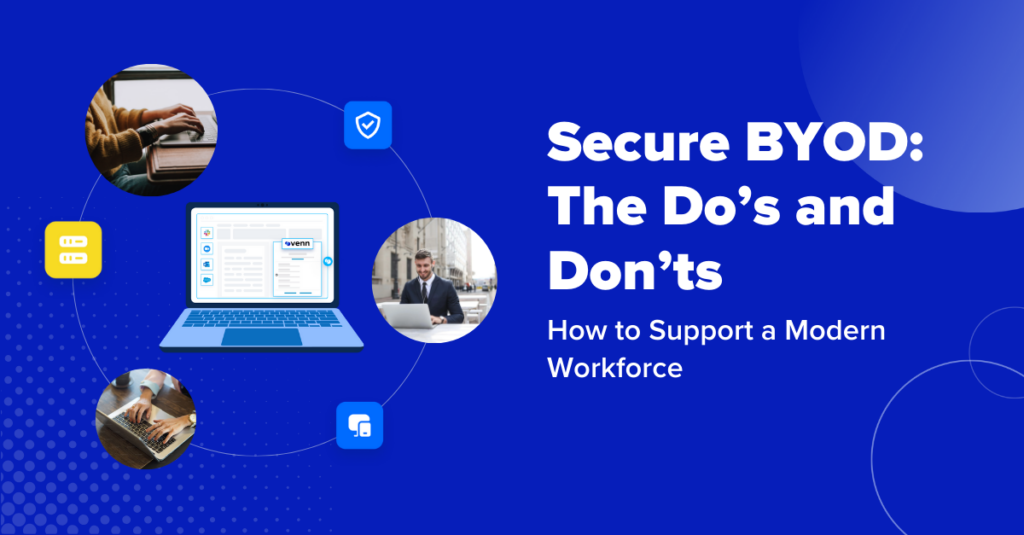Conventional workplace paradigms have evolved into modern BYOD workforces, driven by a more geographically dispersed workforce and employees who want more remote work options and device flexibility. Companies now heavily rely on contractors, freelancers, offshore workers, and remote workers – many of whom use their personal devices for work.
While BYOD workforce policies allow companies and workers more agility and productivity at lower costs, they also present new challenges for IT teams, who must support and secure company data on a variety of unmanaged devices.
In this blog, we will delve into what is vs. what is not secure BYOD so that IT teams can be better equipped to handle this workforce evolution.
What IS Secure BYOD?
1. Ability to Support Personal Devices
Supporting a variety of personal devices is a crucial aspect of a secure BYOD policy.
IT teams must be able to deploy and manage work-related applications on different operating systems and device models. This includes providing remote support for troubleshooting and ensuring consistent performance across all devices.
To achieve this, organizations should utilize a solution that offers remote provisioning, configuration, and support capabilities. These tools enable IT to manage and support personal devices efficiently, ensuring that employees have the necessary resources to perform their work securely.
2. Robust Data Security & Encryption
Data security and encryption are cornerstones of a secure BYOD strategy.
Organizations must implement secure access controls and strong encryption protocols to protect sensitive data both at rest and in transit. This helps meet compliance requirements and mitigates the risk of data breaches.
A comprehensive BYOD policy also includes regular security updates and the adoption of data loss prevention (DLP) tools. These effectively monitor and control the transfer of sensitive information, ensuring robust data security without excessively burdening IT teams.
3. Affordability & Simplicity
For a BYOD strategy to be scalable, it must be both affordable and straightforward, as complex and costly solutions can hinder adoption and strain IT resources.
Companies should seek cost-effective solutions that provide robust security features without unnecessary complexity.
Opting for cloud-based services and leveraging existing infrastructure can help reduce costs. Simplified deployment processes, quick onboarding and offboarding processes, and user-friendly interfaces also contribute to smoother implementation and adoption, ensuring that both employees and IT teams can manage BYOD effectively.
4. Ability to Support all Employees’ Workflows and Access Policies
A secure BYOD solution should support the diverse workflows of all employees. This means accommodating various work environments and application needs, from secure browsers for web-based tasks to specialized applications for specific job functions.
Understanding the unique requirements of different roles within the organization is essential. By offering flexible solutions with adjustable policies for different types of users, companies can ensure that all employees can perform their tasks securely, regardless of their workflow. This holistic approach not only enhances productivity but also reinforces the overall security posture of the organization.
5. Positive User Experience & Complete Separation of Personal and Work
First thing’s first: A secure BYOD strategy does not mean compromising on a great end-user experience.
To ensure high productivity and satisfaction, employees should be able to use the devices that they prefer and are most familiar to them. Having a more native experience and making it easy to switch between work and personal activities on their devices without latency or disruptions are important for user adoption.
Moreover, employees must feel confident that their personal and work data are completely separate. Trust in the BYOD solution grows when users know that their personal information remains private and untouched by their employer, while work-related data is securely managed.
6. Privacy
Along this same vein, ensuring end-user privacy is paramount in any secure BYOD policy.
Employees need assurance that their personal data, apps, and activities are not monitored or accessed by the company. This can be achieved by employing privacy-centric solutions that focus on data protection and transparent policies regarding data access and usage.
Adopting privacy-preserving technologies, such as secure containers or work profiles, can help maintain a clear boundary between personal and work-related activities. Regular communication and education about privacy measures also reinforce trust, making employees more comfortable using their personal devices for work.
What ISN’T Secure BYOD?
- Ignoring Endpoint Security
A major mistake companies make in their BYOD strategies is neglecting endpoint security.
Many organizations take a “wild west” approach to BYOD, where personal devices operate in a work context without stringent security measures. This turning-a-blind-eye is a guaranteed recipe for disaster. Unmanaged endpoints can become easy targets for malware, phishing attacks, and other cybersecurity threats, not to mention are a hindrance to compliance requirements.
A secure BYOD approach requires robust endpoint protection, including antivirus software, firewalls, and intrusion detection systems. Regular security updates and patches are also essential to safeguard against vulnerabilities. Ignoring these fundamental protections can lead to significant data breaches and compromised company networks.
2. Over-Reliance on Traditional VPNs
While Virtual Private Networks (VPNs) offer a basic level of security by encrypting data transmission, they are not sufficient for comprehensive BYOD security. Sole reliance on traditional VPNs can leave gaps in security, especially when it comes to device management and access controls.
Modern BYOD workforces need more advanced solutions that provide granular control over access and continuous monitoring of user activities, ensuring that only authorized users and devices can access sensitive data. Relying solely on VPNs can result in weak points that sophisticated cyber threats can exploit.
3. Infringing on Employee Privacy
But granular control and access must be balanced with a constant maintenance of employee privacy. Some companies make the critical mistake of implementing BYOD policies or solutions that infringe on employee privacy. For example, some organizations install software on user devices that monitor not just what they are doing for work, but also what is happening on the personal side. Not only do these technologies erode trust, but they also violate privacy rights. Such approaches can lead to employee dissatisfaction, legal issues, and potential data misuse.
Secure BYOD solutions must respect the boundary between personal and work-related data. Implementing non-intrusive security measures like containerization, which isolates work data from personal data, helps maintain privacy. Clear communication about what is monitored and why, along with transparent privacy policies, can foster a culture of trust and compliance. Invasive monitoring is counterproductive, oftentimes illegal, and does not align with the principles of a secure and respectful BYOD strategy.
The Right Secure BYOD Solution Should Do It All
In today’s dynamic work environment, finding the right BYOD solution is crucial for balancing productivity, security, and user satisfaction.
To sum it all up, a robust BYOD solution should encompass the following essential features:
- Protect end-user data and privacy
- Completely separate work and personal
- Eliminate latency & IT headaches
- Keep data secure
- Make onboarding and offboarding + remote wipes simple
It may sound like a lot, but there are solutions out there that tick all of the boxes.
Introducing Venn’s Blue Border
Venn is revolutionizing BYOD workforces with the first purpose-built, patented technology for securing contractors and remote workers on personal or unmanaged devices.
By completely separating work and personal on BYOD laptops, Venn protects end-user privacy, secures data, eliminates latency and IT headaches, and makes onboarding and offboarding seamless.
Furthermore, Venn’s solution is more cost-effective & simple than buying, securing, and managing laptops or dealing with virtual desktops.
If you want to learn more about how Venn enables secure BYOD workforces, you can do so here.



